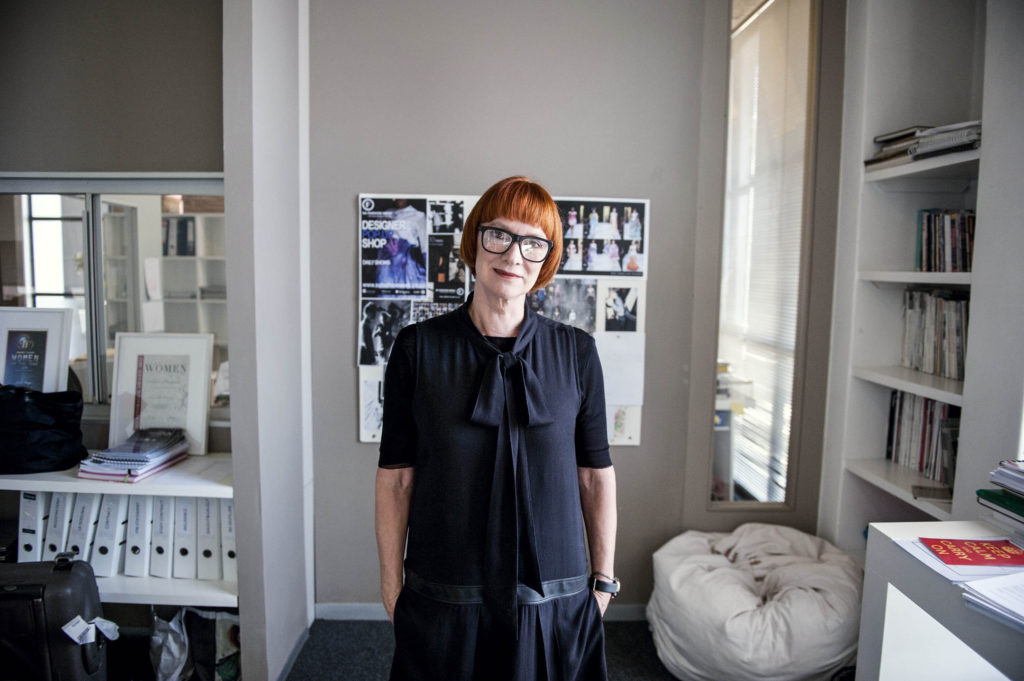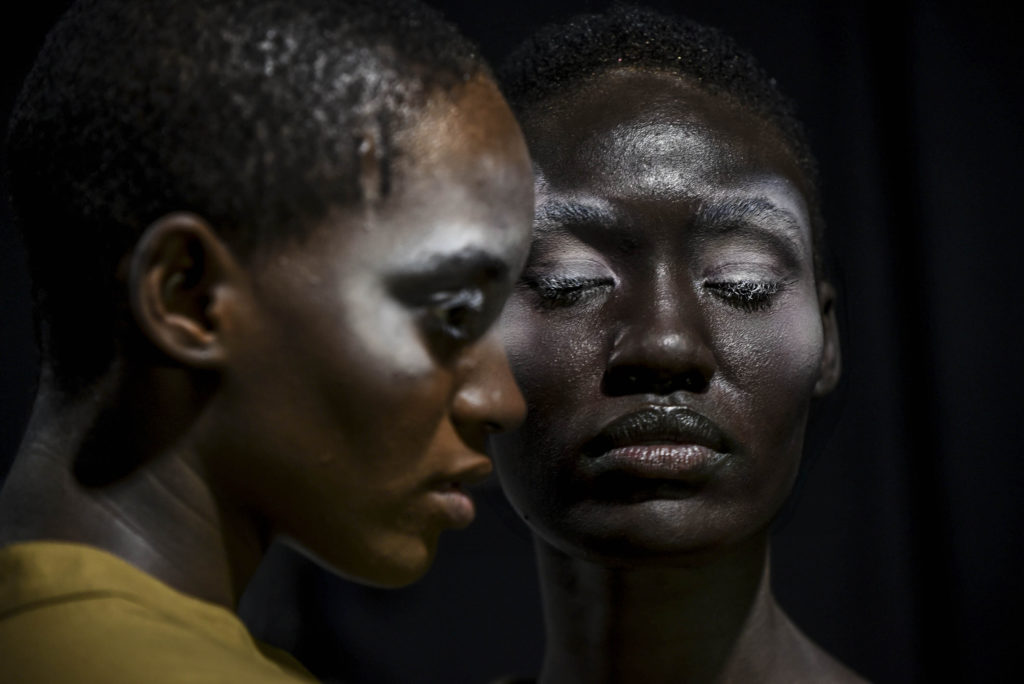Digital is the new black: Designs from The Bam Collective (left), Research Unit and Judith Atelier that were featured in virtual runway shows for South African Fashion Week’s 2020 autumn/winter season
“That work-from-home loungewear that is being dangled so temptingly, so surprisingly affordably, before your screen-weary eyes? Those sweats and sneakers? That potholder? They represent labour and ideas, not just stuff.” — Vanessa Friedman for The New York Times.
South Africa’s fashion industry joins practitioners in music, theatre, television, music and art in looking to the department of sports, arts and culture for financial relief while Covid-19 survival precautions compromise their income.
“To my knowledge, the designers I work with have not been successful in applying for relief funding,” chief executive of South African Fashion Week (SAFW), Lucilla Booyzen, tells the Mail & Guardian.
 SA Fashion Week’s Lucilla Booyzen, SA Fashion Week. (Madelene Cronjé)
SA Fashion Week’s Lucilla Booyzen, SA Fashion Week. (Madelene Cronjé)
When the lockdown began at the end of March, fashion took a backseat, together with other non-essential items and services. Stores were closed and production was put on hold. Local brands had to either hold their breath until regulations allowed them to operate or move online and convince consumers to buy, even when purchases were not being delivered.
Models had DIY shoots in their homes. As per Employment and Labour Minister Thulas Nxesi’s word, workers in the textile industry continued to receive their salaries with the promise that they would work overtime to make up for the loss. African Fashion International Fashion Week cancelled its last day because the presidency had banned gatherings of more than a hundred people by then.
From April 22 to 25, 37 designers were set to show their new collections at the 2020/21 spring/summer season of SAFW. When the lockdown was first extended, the showcase was indefinitely cancelled.
According to SAFW’s 2019 annual report, the biannual event has introduced 500 brands to the wholesale and retail market through runway shows since 1997. After stockists are introduced to designers, SAFW makes its money by having trade shows and pop-up shops that run alongside the runway presentations. Trade shows are a space in which retailers — spanning physical boutiques to online stores — buy items off the runway to sell in their boutiques.
Last year’s trade show had buyers from 124 different establishments in attendance. The pop-ups — which take place at Gauteng shopping meccas like Sandton City Mall and Mall of Africa — give well-off consumers an opportunity to buy runway items before they’re stocked in boutiques. In 2019, the pop-ups’ total turnover was R680 203. These revenues are on hold until pop-ups and trade-shows (mass gatherings in confined spaces) are permitted.
 Behind the scenes images from South African Fashion Week
Behind the scenes images from South African Fashion Week
SAFW was plotting a digital migration long before the lockdown. Over the past few years, Booyzen has become concerned about the function of SAFW, viewing it as increasingly becoming less about the collections on display and more about the people in attendance. “Rather than spending lots of money and having big venues, we were looking at new ways of showing collections,” she says. The plan was to hold intimate shows with fewer attendants.
To make up for a smaller physical audience, SAFW used its social-media platforms and website to roll out video content of the 2020 autumn/winter collections. On its Instagram, for example, SAFW posted 26 virtual runway shows over the course of four days. Designers included Selfi, Artclub and Friends, Bi Parel, The Bam Collective, Research Unit and Judith-Atelier. These collections will be available in stores and online in June and July, meaning the social media roll-outs of the archival video content serve as advertising.
In terms of the reach of this social-media advertising, SAFW has more than 69 000 followers on Instagram, 33 000 on Facebook, 1 130 on YouTube, 1 500 on LinkedIn and 482 000 on Twitter. In 2019, it generated more than 9.9-million impressions across these platforms.
Both the fast and bespoke arms of the fashion industry benefit from riding this advertising wave. Every season, and a few times in between, they have new capsules or collections. When these new garments are ready, their advertising goes to work convincing consumers that what was in last season is now out. Creating this need for what’s new is how they sell units.
From the consumer’s point of view, life under lockdown is an opportunity to reflect on the roles of clothes and how they serve us. On the other hand, the gratification, escapism and hope that comes from online retail therapy can temporarily ease the feelings of boredom, loneliness and panic that come with this lockdown while supporting local brands (read small business).
But it is also the case that fashion platforms need us to buy into their brands for them to keep operations going. As Robyn Keyser of Artclub and Friends told the M&G last week, “I don’t want to encourage people to buy things that they don’t necessarily need”, even though she needs the income.
Deciding which side of the fence to sit on would be easier if production limbo wasn’t threatening, or even erasing, incomes. Designers are artists and their work, although wearable, serves as social commentary for both the designer and the wearer. Their work, and the need to be compensated for it, is valid.
A capsule collection for the new normal
 Japanese Fertile Soil Pyjama blazer from the Viviers’ capsule collection. (Viviers)
Japanese Fertile Soil Pyjama blazer from the Viviers’ capsule collection. (Viviers)
When the presidency began the four-day countdown to lockdown, clothing brand Viviers was able to respond with a plan that readied it to sell winter essentials under level four regulations.
Viviers is a high-end clothing brand that aims to “redefine luxury”, while encouraging its wearers “to be their radical self” through bold shapes, experimental prints and a fearless use of sheer fabric.
The brand’s sustainable “circular design” practice sees it using “fabrics from warehouses that have been sitting with dead-stock from the ’70s”.
In a journal-entry-style write-up on its website, founder Lezanne Viviers recalled the seven weeks that it took for her team to create the winter essentials capsule collection remotely.
Viviers makes use of in-house tailors that have their own sewing machines. So, by the time the lockdown was in place, Viviers’s team of tailors could be been sent home with the “cotton bindings, zips, trimming, hardware [and] labels, along with the precut garments and detailed drawings” that they needed to actualise the collection from the comfort and safety of their homes.
It was possible to make this happen in four days because the collection had already been conceptualised by the end of January.
When the lockdown reached level four, Viviers applied for the essential services permit that allowed it to slowly reopen its studio, make masks and complete its winter essentials capsule collection.
Two weeks later, the studio is open, stocked with its new collection and accepting appointment-only visits.
In addition to highlighting how planning ahead was the brand’s saving grace, the website write-up also acknowledges how life under lockdown demands for cultural practitioners to “adapt and morph into multidisciplinary and multitasking creatives”.
When the collection was ready to be advertised, the show that Viviers had envisioned “quickly had to be reinvented into a presentation that was created in isolation”.
As a result, Viviers and creative director Sithasolwazi Kentane conceptualised, styled, photographed, modelled and edited the collection’s lookbook, and debuted it on the brand’s social-media accounts.